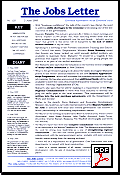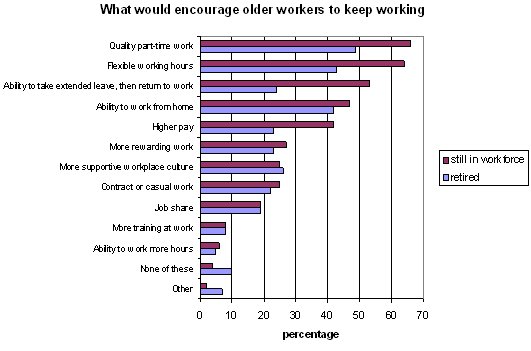



|
 |

|
| No.252 | 9 June 2006 | Essential Information on an Essential Issue |
of key events over the last few weeks. PUBLIC SERVANTS WANTED IN OZ BIG PAY RISES FOR HR STAFF HAVE YOUR SAY ON THE SINGLE CORE BENEFIT “NO GO” LIST OUT-OF-DATE BUDGET 2006 MAORI UNEMPLOYMENT WORKING WHILE PREGNANT WARNING BUY KIWI MADE FURTHER 90-DAY DEBATES LEED: LABOUR MARKET DYNAMICS NO STUDENT LOANS FOR UNSUBSIDISED COURSES WHAT IT TAKES TO KEEP OLDER WORKERS PAST RETIREMENT MICRO-LOANS FOR LOW-INCOME AUSTRALIANS IMMIGRATION IS NOT AN ECONOMIC PANACEA AFRICAN PROFESSIONALS MIGRATING AWAY  LAST Letter
LAST Letter
NEXT Letter   Download this issue as a PDF file
Index to Features
9 May 2006Employers in Britain are employing highly qualified migrants from other EU countries to do low-skilled, low-paying work in the building, hospitality and agriculture sectors according to a survey by the Joseph Rowntree Foundation. The Foundation says many immigrants tolerate low-skilled work and poor conditions in Britain because the pay was considerably better than in their own countries. 12 May 2006British hospital trusts cut 4,000 jobs to stem budget blowouts. In all, the National Health Service may cut as many as 25,000 jobs. 14 May 2006Workers' dissatisfaction with their jobs rises significantly if they are using old computer equipment. A Tickbox.net poll of more than 2,700 office workers in the UK, Germany and France also finds that people working with older computers tend to take more sick leave. 15 May 2006Internet-based job advertisements in NZ fell for the first time in three years according the ANZ job ads survey for March. Newspaper job ad vacancies rose. Up to 50 management, administration and support jobs are expected to be cut from the Hawke's Bay District Health Board, with doctors and nurses being asked to take over the roles. Absenteeism in the meat industry has contributed to a $17 million wage-bill blowout according to a Meat Industry Association report. It says absenteeism accelerates after workers have been employed for six months, the point at which workers no longer have to produce a notice from a doctor for a short illness. Bulgaria, poised to become a member of the EU, is likely to lose a flood of workers when it is accepted. Many workers are expected to head for Britain, Ireland and Sweden — the countries who have allowed wide access to workers from other former Eastern Block countries who have gained entrance to the EU. Australia has a "world-class skills shortage" according to a Grant Thornton survey of Australian employers. 52% of employers are constrained by their lack of skilled staff — a rate only exceeded in the survey by Botswana. Grant Thornton Australian chairman Robert Quant says Australian business owners now regard the skills shortage as the main constraint on expansion and feel they are starting to hit rock bottom as far as the worker availability is concerned. Around 40% of Australian businesses want to increase staff numbers. 16 May 2006About 70 jobs will go as PDL Electronics shuts its Napier plant. After the closure, PDL Napier will have about 20 staff, down from the 230 it had at the end of 2002. 18 May 2006Budget Day. Treasury forecasts employment to fall slightly in the coming year and unemployment to increase to 4.8% by the end of 2007. Treasury also predicts the economy will slow to 1% growth this year before rising to more than 3% in 2007. 19 May 2006Statistics New Zealand reports that the rate of immigration is increasing. There was a net inflow of 10,800 immigrants for the year to April, up from a low of 6,000 last October. 20 May 2006In April, 5,000 fewer trips were made on each of the main motorways into Auckland as fuel costs rose sharply. Public transport use is up, and use of downtown car parks has fallen as workers change their behavior. 22 May 2006The government is asking 12_24 year olds their opinions about youth rates and the minimum wage. The Ministry of Youth Development has printed 100,000 postcards that are being distributed primarily through schools and tertiary education providers to help get the issue circulating. It has also developed an on-line survey. The Youth Minimum Wage poll can be found here. An immigration loophole is closed that had allowed foreign fee-paying students to qualify as domestic NZ, non-fee paying students. Until the rule change, the guardian of a foreign student was eligible to apply for a work permit, and students whose guardian is entitled to work qualified them as domestic students. 23 May 2006Qantas Airlines will cut another 1,000 management and administration jobs by the end of the year. The job losses are due primarily to increased fuel costs which have nearly doubled over the last two years. Malaysian Airlines is to lay off about 6,000 staff, a quarter of its workforce. Factors affecting the airline includes rising fuel prices. 24 May 2006The idea of a seasonal programme for Pacific peoples to come to NZ to work appears to have progressed. After meeting the foreign affairs minister of PNG Rabbie Namaliu, NZ Foreign Minister Winton Peters says such a scheme could benefit the NZ economy as well as helping to alleviate unemployment in the Pacific. US food giant Kraft axes 325 jobs in Australia in the latest round of a two-year cost cutting programme. 25 May 2006Online job search site www.search4jobs.co.nz is launched by APN, the publisher of the NZ Herald. The site immediately lists 6,000 jobs. The Green Party warns that a Work & Income proposal to assess the income of all beneficiaries on a week-to-week basis would have a "devastating" effect on people who get seasonal work. MP Sue Bradford says there is no reason to assume a one-size-fits-all approach and such a move would make a mockery of the government's assurance that no one would be worse off with the introduction of a Single Core Benefit. Over 60 secondary school students from Northland to South Auckland take a look at careers in the agricultural sector at an Experience Day at Ambury Park, sponsored by Meat & Wool NZ. In Australia, sole parents who are judged capable of working will be expected to take jobs that pay as little as $20/wk more than a benefit. Parents who do not take jobs may be subjected to 8-week benefit suspension penalties. 26 May 2006About 330 people are made redundant at Te Wananga o Aotearoa in Waikato. The losses are mainly of middle management and support staff. Redundant staff will be able to apply for 150 new positions. 28 May 2006The NZ balance of payments for imported and exported merchandise was positive in April. This is the second month running that the NZ economy has run a trade surplus. For three years NZ has run trade deficits. 29 May 2006500 Australian jobs are to be cut as Vodafone unveils plans to slash overheads by up to 20% over the next few years. Economic growth will hit a low of 0.8% in the year to March 2007 according to NZIER. The economic research bureau also predicts that the following year economic growth will be 2%, significantly lower than the Treasury forecast of 3.3% for the period. 30 May 2006NZ workers value the people they work with and their work environment more than the money they get according to the Monday Project. The TNS survey, that attempts to measure NZ worker's attitudes to how they feel about work, can be downloaded (11pg, 45Kb) from here. Hundreds of mail worker's will lose their jobs next year as NZ Post puts $80 million into new processing machines in six urban areas to deal with its new postcode system. A severe shortage of workers will constrain the growth of the Australian mining sector for at least the next ten years according to research commissioned by the Minerals Council of Australia. Researchers say staff are already scarce but the mining workforce is expected to expand by 50% in the next decade. The report recommends mining companies use more skilled migrants, the government to create of a new visa category to cater for short term labour needs, and reclassify geologists and metallurgists to allow them easier entry into Australia. 31 May 2006The proportion of Maori on the unemployment register has increased in relation to the proportion of Pakeha but the overall number of unemployed people in both groups has fallen. Minister of Maori Affairs Parekura Horomia points out that since 2000, the number of Maori receiving an unemployment benefit has fallen in Northland by 58%, in Bay of Plenty by 65% and in East Coast by 71%. The minerals industry in Australia faces a "critical" shortage of skilled labour. Stockbroking firm Teather & Greenwood says the shortage indicates that mines are working flat out and have no real prospect of any substantial growth over the next two to three years. 80% of IT professionals feel stressed by just thinking about going to the office and 97% are "traumatised" by their daily work, according to a survey by Dublin-based consulting firm Skillsoft. Eunuchs in India call for a fair share of government jobs at a gathering in Bombay. The government has legislated that lower castes in India be allotted a proportion of jobs and schooling places, but there are no such allotments for India's 500,000 eunuchs. 1 June 2006A severe influenza pandemic is likely to immediately reduce New Zealand's economy by 5%-10% according to NZIER. Economist Brent Layton estimates a severe pandemic would have similar first-year impacts to the 1931-1933 Great Depression, but much smaller cumulative impacts over four years. An Indonesian national is sentenced to four and a half years prison for bringing several of his countrymen into NZ with the promise they could get legal work in the fruit industry. The duped immigrants — who had paid the man $8,000 each — have already been deported. Unemployment is estimated to be 85% in the West African nation of Liberia. The UN says the creation of "jobs, jobs, jobs" is a top priority in the country and urges rapid debt relief, international assistance and other measures to foster growth and development. The humanitarian situation in the occupied Palestinian territory is looking "extremely bleak and predicted to worsen" according to the UN Office for the Coordination of Humanitarian Affairs. The agency calls for $385 million to help alleviate the impact of soaring joblessness and the collapse in family income through the creation of emergency employment and to prevent increased malnutrition through expanded food assistance to families who don't have enough food. 3 June 2006The Green Party elects Russell Norman as its co-leader. 4 June 2006Grocery giant Foodstuffs is to introduce the first of two self-service supermarket checkouts at a Pak `N Save store in Christchurch this month. Foodstuff's Mark Baker says reduced labour costs aren't part of the business case for the move but agrees that stores may not need so many checkout operators early in the morning or late at night. The unbundling of Telecom's network may be derailed by a chronic shortage of skilled network technicians according to contracting company Cabletalk. Managing director Peter Wilson says NZ has only 75% of the network technicians it currently needs and would need a lot more in an unbundled world. 5 June 2006Nearly 50 jobs go at the Henderson-based Waipareira Trust, now being managed by former manager and MP John Tamihere. The cuts come from the trust's training and education service, call centre and building development company.
 LAST Diary
LAST Diary
NEXT Diary 
|
PUBLIC SERVANTS WANTED IN OZ New Zealand civil servants are being targeted by recruitment agencies trying to fill
7,000 Australian public service job vacancies. About 3,000 of the new jobs will be situated in Canberra,
a city that is already suffering a long-term skills shortage. Canberra has the lowest unemployment rate
in Australia (3.4%) and observers say the jobs being created in the 2006-07 financial year will
further stretch the city's labour market. New Zealand civil servants are being targeted by recruitment agencies trying to fill
7,000 Australian public service job vacancies. About 3,000 of the new jobs will be situated in Canberra,
a city that is already suffering a long-term skills shortage. Canberra has the lowest unemployment rate
in Australia (3.4%) and observers say the jobs being created in the 2006-07 financial year will
further stretch the city's labour market.
With civil servants in such demand in Australia, Wellington is an obvious place to look for talent. One company, Canberra-based Recruitment Management, says that many people working in the government sector in Wellington will have the appropriate skills needed by the Australian public sector. Source — Dominion Post, 27 May 2006, "Aussies launch jobs raid on NZ" by Keri Welham
BIG PAY RISES FOR HR STAFF As a group, human resources (HR) specialists — the people whose job it is to find and
retain staff — have had very high pay rises over the last year. Typical salaries for HR specialists in
Auckland rose 18.3%, the biggest overall salary increase of all working roles monitored by the
2006 Hays Salary Survey. Hays regional director Jason Walker says the focus on recruitment and retention of staff
for many organisations has driven demand for HR specialists. Walker: "The last 12 months
was characterised by one of the most sustained periods of low unemployment and jobs growth in
modern times, the well publicised joining of Generation Y candidates to the workforce and the fierce
global resources boom. So it is no surprise it was a year with an unprecedented focus on the candidate." As a group, human resources (HR) specialists — the people whose job it is to find and
retain staff — have had very high pay rises over the last year. Typical salaries for HR specialists in
Auckland rose 18.3%, the biggest overall salary increase of all working roles monitored by the
2006 Hays Salary Survey. Hays regional director Jason Walker says the focus on recruitment and retention of staff
for many organisations has driven demand for HR specialists. Walker: "The last 12 months
was characterised by one of the most sustained periods of low unemployment and jobs growth in
modern times, the well publicised joining of Generation Y candidates to the workforce and the fierce
global resources boom. So it is no surprise it was a year with an unprecedented focus on the candidate."
In more general terms, the survey reveals that about a quarter of workers had a pay rise of less than 3% (if they had one at all) last year. More than half of workers (58%) had pay rises of 3%-6%. And about 17% of workers had pay rises of more than 6%. The Hays Salary Survey covers 13 employment sectors and hundreds of job roles in Auckland, Christchurch and Wellington. Source — New Zealand Herald, 1 June 2006, "Pay rises: Who's doing best in the tight labour market" by NZPA; media release Hays, 31 May 2006, "Salary survey released: Job growth strong - salaries stay moderate".HAVE YOUR SAY ON THE SINGLE CORE BENEFIT Work & Income is moving on plans to replace seven social welfare benefits with a Single
Core Benefit — and is asking for feedback on the changes it is proposing. Work & Income is moving on plans to replace seven social welfare benefits with a Single
Core Benefit — and is asking for feedback on the changes it is proposing.
A Single Core Benefit will incorporate the Unemployment, Sickness, Invalids, Widows and the various Domestic Purposes Benefits. The current system categorises people in most of these groups as "unable to work" and that is destined to change with the introduction of a Single Core Benefit. Work & Income's New Service Model (see Jobs Letter No 251) is already seeing the agency provide employment services for all new working-aged clients, rather than just for those who would qualify for an Unemployment Benefit. The Single Core Benefit will further remove distinctions about who is expected to work and who is not. — eligibility —what age should a person be and what residency status should they have to be eligible for a benefit? and for people who need income assistance because they have a low-income from a job, should their eligibility be based on the number of hours they work (currently 30/wk) or on the amount they earn? —16 and 17 year olds— if a different benefit is to be available for young people in special circumstances, on what basis should it be available? and should it have a work focus or an education and training focus? — work expectations — what work expectations are reasonable for people of working age who have dependent children or other caring responsibilities, or who have medical conditions or disabilities? — assessment of earnings — should income be assessed weekly or annually? and what abatement regime should be used? — services — how can Work & Income change the services it offers to better support people to enter and remain in work? and what services should be offered to people who can't return to work immediately? Providing feedback on the Single Core Benefit proposals questionnaire can be found here. Source — Work & Income website "Providing feedback on the Single Core Benefit proposals"; media release the Green Party by Sue Bradford, 26 may 2006, "Action alert - single core benefit consultation".
"NO GO" LIST OUT-OF-DATE Some communities feel they should be taken off Work & Income's "no go" areas list.
Two years ago as one of the Jobs Jolt initiatives, Work & Income identified 259 areas where it deemed
job opportunities to be too low (see Jobs
Letter No 202) and Cabinet gave the agency the power to
deny an unemployment benefit to anyone who moved into one of these areas and couldn't find a job. Some communities feel they should be taken off Work & Income's "no go" areas list.
Two years ago as one of the Jobs Jolt initiatives, Work & Income identified 259 areas where it deemed
job opportunities to be too low (see Jobs
Letter No 202) and Cabinet gave the agency the power to
deny an unemployment benefit to anyone who moved into one of these areas and couldn't find a job.
But people living in some of these areas say the "no go" list is out-of-date. Masterton Mayor Bob Francis points to seven towns in his district on the "no go" list that no longer should be there. Riversdale, Castlepoint, Cape Palliser and Lake Ferry have all benefited from a real estate boom. And Mauriceville, Battersea and Matahiwi all now have growing economies. Francis: "I would certainly question the ongoing identification of those areas. In fairness to the government the idea had merit at the time, but I think it's irrelevant today, in our case." Several towns to the south of Nelson are also tagged "no go". Tadmor resident Gay Hamilton says the area is thriving and there is no need to be unemployed. She says residents are upset by the "no go" listing, which they feel labels them as dole bludgers. Source — Dominion Post, 23 May 2006, "Country towns fight blacklist on benefits" by Anna Chalmers.
BUDGET 2006— Industry Training — There will be an additional $4.44 million per year put into Industry Training, bringing its total annual budget to $15.6 million. The government has a target 250,000 people participating in structured workplace learning every year. — Workforce Foundation Skills — The Budget provides a further $33.5 million over four years towards improving the literacy, numeracy and language foundation skills of people employed at the low-skill end of the workforce. The funding will go through about 20 industry training organisations and will, by 2009/10, see 8,950 trainees per year funded to improve their foundation skills as part of their workplace training. — Modern Apprenticeships — The Budget included an additional $34.4 million to expand the number of Modern Apprenticeships so there will be 14,000 apprentices enrolled in the programme per year by December 2008. — Workplace Training in Schools — The Gateway programme, through which year 11-13 secondary school students take part of their course of study in a workplace, is being expanded. The $8.1 million increase will see Gateway — which has only been available in decile 1-6 school — extended to all state and integrated schools. — Tertiary Students — The bonded merit scholarship scheme will be expanded from 500 to 1,000 scholarships from the new school year. The scheme provides scholarships of $3,000 per year for course fees for up to four years of study. The bonded student is required to work in New Zealand for the same number of years for which they received the scholarship. If they move overseas, they are required to re-pay the portion of their scholarship that didn't meet their obligation. The expansion to the scheme will cost $13 million. More students will become eligible for student allowances as the income threshold for their parents is to be lifted by 10% from $35,700 to $39,270. Students whose parents or guardians earn less than this per year will get a full student allowance. The change will cost $14.3 million. — Early Childcare — The implementation of 20 hours per week of free early childhood education for working parents will become available from July 2007. The move will cost $162 million. Source — Budget speech 2006 by Michael Cullen; media release by NZ government by Michael Cullen, 18 May 2006, "Budget 2006: Further financial help for students"; Source _ Media release NZ government by Michael Cullen, 18 May 2006, "Budget 06: Improving skills of the workforce".
MAORI UNEMPLOYMENT At 8.6%, the Maori unemployment rate is at the lowest annual average in 20 years,
according to the March 2006 Household Labour Force
Survey. Minister of Maori Affairs Parekura Horomia
is pleased with the improvement in Maori unemployment since the government came to power in
1999 and points out that the proportion of Maori in work has been climbing steadily. The labour
force participation rate for Maori increased from 62.4% in 1999 to 67.1% now. The labour
force participation rate for Europeans is 69.6% and for Pacific People 62.7%. And hourly earnings by
Maori have risen an average of 4% between June 1999 and June 2005, from $13.11 to $16.58. Over
the entire economy, wages increased by 3.8% over the period. At 8.6%, the Maori unemployment rate is at the lowest annual average in 20 years,
according to the March 2006 Household Labour Force
Survey. Minister of Maori Affairs Parekura Horomia
is pleased with the improvement in Maori unemployment since the government came to power in
1999 and points out that the proportion of Maori in work has been climbing steadily. The labour
force participation rate for Maori increased from 62.4% in 1999 to 67.1% now. The labour
force participation rate for Europeans is 69.6% and for Pacific People 62.7%. And hourly earnings by
Maori have risen an average of 4% between June 1999 and June 2005, from $13.11 to $16.58. Over
the entire economy, wages increased by 3.8% over the period.
 Maori Party co-leader Pita Sharples is disturbed by the Minister's interpretation of the
Maori unemployment figures. Sharples points out that in the same
Household Labour Force Survey, the unemployment rate for European/Pakeha was 3.2%, Pasifika peoples 7.6% and Maori 8.7%.
Sharples asks, "Since when is `last place' a sign of success?" Sharples: "The Maori Party is tired of the
endless disparities being recorded in such vital indicators as employment, unemployment and income.
The Maori Party believes in the potential of Maori to earn the same as any other New Zealander, to
enjoy full employment, and to experience the obvious economic benefits that come with an improved position.
That would be something that we can all celebrate. We would urge the Minister of Maori Affairs to
lift his sights higher, and to stop settling for second-best, or in this case, last place". Maori Party co-leader Pita Sharples is disturbed by the Minister's interpretation of the
Maori unemployment figures. Sharples points out that in the same
Household Labour Force Survey, the unemployment rate for European/Pakeha was 3.2%, Pasifika peoples 7.6% and Maori 8.7%.
Sharples asks, "Since when is `last place' a sign of success?" Sharples: "The Maori Party is tired of the
endless disparities being recorded in such vital indicators as employment, unemployment and income.
The Maori Party believes in the potential of Maori to earn the same as any other New Zealander, to
enjoy full employment, and to experience the obvious economic benefits that come with an improved position.
That would be something that we can all celebrate. We would urge the Minister of Maori Affairs to
lift his sights higher, and to stop settling for second-best, or in this case, last place".
Source — Media release NZ government by Parekura Horomia, 11 May 2006, "Minister welcomes HLFS confirmation"; Media release Maori Party by Pita Sharples, 12 May 2006, "Since when is `last place' a sign of success?".
WORKING WHILE PREGNANT WARNINGA Dutch study of 7,051 women and their babies found that pregnant women in high-stress jobs who work 32 hours per week or more deliver babies with significantly lower than normal birth weight. Thin babies are more likely to become obese later in life and have a higher risk of heart attack, stroke and diabetes. The study also found that stressed mothers are more likely to have complications with their pregnancies and have babies who cry excessively. Research leader Gouke Bonsel: "We were astonished and we thought long and hard about publishing the results, but it is perfectly clear: women who work 32 hours or more in a stressful position have noticeably lighter children, with all the consequences." Source — Sunday Star Times, 21 May 2006 "Pregnant women urged to halve work hours" by Jennifer Dann; The Age, 1 May 2006, "Pregnant women should `halve' work hours" — DPA
BUY KIWI MADE The inaugural Buy Kiwi-Made campaign has been allocated $11.5 million over the next
three years. Government spokesperson for the campaign Sue Bradford says the money will partly be used
to produce and screen television ads and other marketing strategies. But she says
Buy Kiwi-Made will be much more than media marketing. The campaign will be to provide the information consumers need
to buy local and encourage New Zealanders to buy locally made products, use local services and to
be local tourists. The inaugural Buy Kiwi-Made campaign has been allocated $11.5 million over the next
three years. Government spokesperson for the campaign Sue Bradford says the money will partly be used
to produce and screen television ads and other marketing strategies. But she says
Buy Kiwi-Made will be much more than media marketing. The campaign will be to provide the information consumers need
to buy local and encourage New Zealanders to buy locally made products, use local services and to
be local tourists.
The intention of Buy Kiwi-Made is to support manufacturers who want to identify their products as made in New Zealand, encourage retailers to be more pro-active in promoting New Zealand-made products, see local firms buying from other local firms, see that government procurement policies give local firms a fair go, and support the growth of the buy local initiatives such as local government procurement and craft and farmers markets. Bradford: "We correctly acknowledge those high profile Kiwis who excel in sports or in film. But it is time that we also value those who keep this country working; those who make the products and provide the services that we consume every day."  For 28 years the Buy New Zealand Made
campaign has been run by Business New Zealand. It distinguishes its 700 members' products with a distinctive triangular sticker with a stylised kiwi on
it. Buy New Zealand Made director Dalton Kelly says his subscribers — most of them
small manufacturing businesses — pay to use the logo and he hopes
Buy New Zealand Made will get some of the new
Buy Kiwi-Made funds to encourage more manufacturers to sign up and benefit from
the consumer awareness the government campaign will create. Kelly: "Countries like Australia and
Ireland have funded large media campaigns which tugged at people's heartstrings to get them to buy locally
and we've never done that. And compared to those places, New Zealanders are not nearly as loyal in
what they buy." For 28 years the Buy New Zealand Made
campaign has been run by Business New Zealand. It distinguishes its 700 members' products with a distinctive triangular sticker with a stylised kiwi on
it. Buy New Zealand Made director Dalton Kelly says his subscribers — most of them
small manufacturing businesses — pay to use the logo and he hopes
Buy New Zealand Made will get some of the new
Buy Kiwi-Made funds to encourage more manufacturers to sign up and benefit from
the consumer awareness the government campaign will create. Kelly: "Countries like Australia and
Ireland have funded large media campaigns which tugged at people's heartstrings to get them to buy locally
and we've never done that. And compared to those places, New Zealanders are not nearly as loyal in
what they buy."
Source — Media release NZ government by Sue Bradford and Trevor Mallard, 15 May 2006, "Funding set aside for Buy Kiwi-Made programme in Budget 2006; Speech by Sue Bradford, 15 May 2006, "Pre-Budget Buy Kiwi Made Announcement"; Sunday Star Times, 28 May 2006, "Buy the best, or buy NZ?" by Greg Ninness.
FURTHER 90-DAY DEBATES The 90-day Probationary Employment Bill — currently before a parliamentary
selective committee — (see Jobs Letter
No 248, 249, 250) is still being hotly debated in the media. Author
of the Bill, National MP Wayne Mapp, says giving employers the flexibility to dismiss workers who are
not working out in the early stages would improve New Zealand's competitiveness. Mapp points out
that New Zealand has recently dropped from 16th to 22nd in the OECD's competitiveness rankings.
He believes the government is making it harder for business, rather than easier, and points to a
Treasury report in 2005 which warned that labour laws could eventually reduce New Zealand's
competitiveness. Mapp: "International competitiveness is a whole lot of little things cumulatively adding up and we
are slowly slipping down". The 90-day Probationary Employment Bill — currently before a parliamentary
selective committee — (see Jobs Letter
No 248, 249, 250) is still being hotly debated in the media. Author
of the Bill, National MP Wayne Mapp, says giving employers the flexibility to dismiss workers who are
not working out in the early stages would improve New Zealand's competitiveness. Mapp points out
that New Zealand has recently dropped from 16th to 22nd in the OECD's competitiveness rankings.
He believes the government is making it harder for business, rather than easier, and points to a
Treasury report in 2005 which warned that labour laws could eventually reduce New Zealand's
competitiveness. Mapp: "International competitiveness is a whole lot of little things cumulatively adding up and we
are slowly slipping down".
 But Minister of Labour Ruth Dyson says the Employment Probation Bill is not in step with
a World Bank survey that has ranked New Zealand the number one easiest country in the world in
which to do business. And the World Bank ranked New Zealand 4th out of 155 countries for ease
of employers starting or ending an employment relationship. Dyson also says that the World Bank
"rigidity of employment index" rates New Zealand as having one of the least rigid employment markets in
the OECD. Dyson: "These findings essentially render Dr Mapp and his Probationary Employment
Bill redundant, as every country he has compared New Zealand to has a more rigid
employment environment, despite having the punitive probationary periods that he advocates in his Bill." But Minister of Labour Ruth Dyson says the Employment Probation Bill is not in step with
a World Bank survey that has ranked New Zealand the number one easiest country in the world in
which to do business. And the World Bank ranked New Zealand 4th out of 155 countries for ease
of employers starting or ending an employment relationship. Dyson also says that the World Bank
"rigidity of employment index" rates New Zealand as having one of the least rigid employment markets in
the OECD. Dyson: "These findings essentially render Dr Mapp and his Probationary Employment
Bill redundant, as every country he has compared New Zealand to has a more rigid
employment environment, despite having the punitive probationary periods that he advocates in his Bill."
 In an opinion piece in the Dominion
Post, Mark Harcourt from Waikato Management
School, agrees that many people have problems getting their foot in the jobs door but he says a
probationary employment law won't solve their problems. Harcourt says the issue with migrants is
demonstrably about discrimination — not a lack of qualifications or work experience. And for Maori and
Pacific young people, insufficient training and education — not employers' fear of wrongful dismissal
litigation — better explains the higher than average unemployment rates. Harcourt says there is no evidence
from the United Kingdom or the United States — that respectively have very long or indefinite
probation periods — suggests that probationary employment significantly reduces the relatively
high unemployment rates of disadvantaged groups. In an opinion piece in the Dominion
Post, Mark Harcourt from Waikato Management
School, agrees that many people have problems getting their foot in the jobs door but he says a
probationary employment law won't solve their problems. Harcourt says the issue with migrants is
demonstrably about discrimination — not a lack of qualifications or work experience. And for Maori and
Pacific young people, insufficient training and education — not employers' fear of wrongful dismissal
litigation — better explains the higher than average unemployment rates. Harcourt says there is no evidence
from the United Kingdom or the United States — that respectively have very long or indefinite
probation periods — suggests that probationary employment significantly reduces the relatively
high unemployment rates of disadvantaged groups.
Harcourt says that if firing incompetents or wrongdoers is so difficult, then perhaps explicit default dismissal procedures for poor performance, misconduct and redundancy should be added to the Employment Relations Act. Harcourt: "But we should not expect the most vulnerable groups in our community to carry the entire burden in the form of probationary employment contracts."  Business NZ says union statements suggesting thousands of workers would be sacked
every three months if the Probationary Employment Bill is adopted are "silly". Business NZ chief Phil
O'Reilly points out that the costs of advertising, selection, induction, training, uniforms and the cost of settling in
a new worker are huge. O'Reilly: "Employers hire employees in the hope and expectation that they
will be successful; to suggest otherwise flies in the face of reality." Business NZ says union statements suggesting thousands of workers would be sacked
every three months if the Probationary Employment Bill is adopted are "silly". Business NZ chief Phil
O'Reilly points out that the costs of advertising, selection, induction, training, uniforms and the cost of settling in
a new worker are huge. O'Reilly: "Employers hire employees in the hope and expectation that they
will be successful; to suggest otherwise flies in the face of reality."
Source — The Independent, 24 May 2006, "Is a probation period necessary?" by Wilson Owen; Dominion Post, 25 May 2006, "Jobs bill won't work" by Mark Harcourt; New Zealand Herald, 7 June 2006, "Worker's payout for filthy graffiti" by Claire Trevett.
LEED — LABOUR MARKET DYNAMICS
NO STUDENT LOANS FOR UNSUBSIDISED COURSESSource — New Zealand Herald, 26 May 2006, "Training sites face close in loans change" by Stuart Dye; media release by Education Forum, 26 May 2006, "Student loan access for thousands under threat".WHAT IT TAKES TO KEEP OLDER WORKERS PAST RETIREMENT Flexible working hours and more part-time positions are the key to retaining older workers
in the workplace, according the Equal Employment Opportunities (EEO) Trust. In an on-line survey,
the EEO has explored what people want from work as they get older and what workplace
conditions would encourage them to stay in paid-work longer. About two-thirds of those responding said
they would be encouraged to continue working past their expected retirement date by the availability
of quality part-time work and flexible working hours. Flexible working hours and more part-time positions are the key to retaining older workers
in the workplace, according the Equal Employment Opportunities (EEO) Trust. In an on-line survey,
the EEO has explored what people want from work as they get older and what workplace
conditions would encourage them to stay in paid-work longer. About two-thirds of those responding said
they would be encouraged to continue working past their expected retirement date by the availability
of quality part-time work and flexible working hours.
The survey also found that most of those who responded who were already retired had gone directly from working into full-time retirement. But they said they would prefer to still be doing some paid work. EEO Trust chief executive Philippa Reed says changing demographics and the on-going skills shortage means employers need to sharpen up on the employment of older people. Reed: "As well as ensuring they attract young people entering the workforce, employers need to explore what incentives, training and other workplace initiatives would encourage older people to continue to make an effective contribution at work."
 image source - EEO Trust
— EEO Trust Work & Age Survey Report 2006, 29 May 2006, published by the EEO Trust, can be downloaded (42pg, 771Kb) from here. Source — EEO Trust Work & Age Survey Report 2006; media release from EEO Trust from Josie Falani, 29 May 2006, "Flexible working options attract older workers; New Zealand Herald, 29 May 2006, "Older workers seek flexible hours in the workplace" by NZPA.
MICRO-LOANS FOR LOW-INCOME AUSTRALIANSBrotherhood executive director Tony Nicholson says around 6% of adult Australians have minimal access to financial services and therefore rely on very expensive forms of credit or simply go without household items that most people take for granted. Nicholson: "Families we work with survive without a fridge or a washing machine, using an esky to keep food cool and visiting the laundromat on a daily basis. Over the space of a year this adds up to more than the cost of a personal loan. With Progress Loans, we will be able to assist many of these families on low-incomes to borrow money via the mainstream credit market in a way which is sustainable and protects them from exploitation." Source — Jobs Australia, 27 May 2006, "The NAB gets generous".
IMMIGRATION IS NOT AN ECONOMIC PANACEACommissioner Judith Sloan questions the assumption that skilled migration delivers much in the way of wide economic benefits. Sloan agrees that a 50% increase in skilled migration would relieve some of the pressures of skills shortages. But she maintains that the improvements in welfare associated with increased migration are largely accrued by the immigrants themselves and that the overall effect of greater migration would be fairly minor for the economy. The findings are a rebuff to business groups and the Victorian state government, which are lobbying the Australian Federal government hard for a big increase in skilled immigration numbers. Source — The Age, 17 May 2006, "Immigration won't fix skills shortage: report" by Tim Colebatch
AFRICAN PROFESSIONALS MIGRATING AWAYThe British Association of University Teachers and the British lecturers' union Natfhe say something needs to be done to compensate developing countries for their human resource losses. They suggest reciprocal migration, better links between universities in industrialised countries and those in developing nations, and improving the infrastructure of the countries faced with losing their workers. Paul Bennett of Natfhe says the UK hosts many of the most talented academics from around the world, including some from very poor countries. Bennett: "They are entitled to come, are very welcome, and our universities benefit hugely from them. But this is an unequal relationship which can sometimes damage the countries from which they come. We want the government to compensate those exporter countries and help them to build up their own education systems." Source — Guardian Weekly, 31 March - 6 April, "Africa suffering from brain drain" by Liz Ford. |